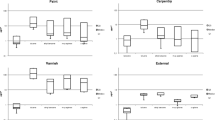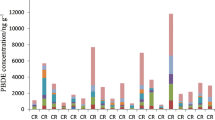Abstract
Objective: The principal aim of the study was to estimate the level of exposure to organic solvents of graffiti removers, and to identify the chemicals used in different cleaning agents. A secondary objective was to inform about the toxicity of various products and to optimise working procedures. Methods: Exposure to organic solvents was determined by active air sampling and biological monitoring among 38 graffiti removers during an 8-h work shift in the Stockholm underground system. The air samples and biological samples were analysed by gas chromatography. Exposure to organic solvents was also assessed by a questionnaire and interviews. Results: Solvents identified were N-methylpyrrolidone (NMP), dipropylene glycol monomethyl ether (DPGME), propylene glycol monomethyl ether (PGME), diethylene glycol monoethyl ether (DEGEE), toluene, xylene, pseudocumene, hemimellitine, mesitylene, ethylbenzene, limonene, nonane, decane, undecane, hexandecane and γ-butyrolactone. The 8-h average exposures [time-weighted average (TWA)] were below 20% of the Swedish permissible exposure limit value (PEL) for all solvents identified. In poorly ventilated spaces, e.g. in elevators etc., the short-term exposures exceeded occasionally the Swedish short-term exposure limit values (STEL). The blood and urine concentrations of NMP and its metabolites were low. Glycol ethers and their metabolites (2-methoxypropionic acid (MPA), ethoxy acetic acid (EAA), butoxy acetic acid (BAA), and 2-(2-methoxyethoxy) acetic acid (MEAA)) were found in low concentrations in urine. There were significant correlation between the concentrations of NMP in air and levels of NMP and its metabolites in blood and urine. The use of personal protective equipment, i.e. gloves and respirators, was generally high. Conclusions: Many different cleaning agents were used. The average exposure to solvents was low, but some working tasks included relatively high short-term exposure. To prevent adverse health effects, it is important to inform workers about the health risks and to restrict the use of the most toxic chemicals. Furthermore, it is important to develop good working procedures and to encourage the use of personal protection equipment.
Similar content being viewed by others
Author information
Authors and Affiliations
Additional information
Received: 20 October 1999 / Accepted: 4 March 2000
Rights and permissions
About this article
Cite this article
Anundi, H., Langworth, S., Johanson, G. et al. Air and biological monitoring of solvent exposure during graffiti removal. Int Arch Occup Environ Health 73, 561–569 (2000). https://doi.org/10.1007/s004200000157
Issue Date:
DOI: https://doi.org/10.1007/s004200000157




